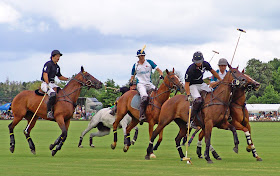
Polo is thought to have originated in China and Persia around 2,000 years ago. The name of the game may well come from the word “pholo” meaning 'ball' or 'ballgame' in the Balti language of Tibet.
"Polo players at their game", detail on the west wall of a tomb pathway of Prince Zhang Huai's tomb, interred in 706 AD during the Tang Dynasty of China. The tomb is part of the larger Qianling Mausoleum near modern-day Xi'an (formerly Chang'an, the Tang capital).
The first recorded game took place in 600BC between the Turkomans and Persians (the Turkomans won). In the fourth century AD, King Sapoor II of Persia learned to play, aged seven. In the 16th century, a polo ground (300 yards long and with goalposts eight yards apart) was built at Ispahan, then the capital, by Shah Abbas the Great.
The Moguls were largely responsible for taking the game from Persia to the east and, by the 16th century, the Emperor Babur had established it in India. (It had already long been played in China and Japan, but had died out by the time the West came in contact with those countries). In the 1850s, British tea planters discovered the game in Manipur (Munipoor) on the Burmese border with India. They founded the world’s first polo club at Silchar, west of Manipur. Other clubs followed and today the oldest in the world is the Calcutta Club which founded in 1862.
Malta followed in 1868 because soldiers and naval officers stopped off there on their way home from India. In 1869, Edward “Chicken” Hartopp, of the 10th Hussars, read an account of the game in The Field magazine while stationed at Aldershot and, with fellow officers, organised the first game. Then known as “hockey on horseback,” it was played on a hastily-rolled Hounslow Heath where a shortlist of about 10 rules was also hastily assembled.
But, it was John Watson (1856-1908), of the 13th Hussars, who formulated the first real rules of the game in India in the 1870s. He later formed the celebrated Freebooters team who won the first Westchester Cup match in 1886. He was a key player at the All Ireland Polo Club which was founded in 1872 by Horace Rochfort of Clogrenane, County Carlow.
The first polo club in Britain was Monmouthshire, founded in 1872 by Captain Francis Herbert (1845- 1922), of the 7th Lancers, at his brother's estate at Clytha Park, near Abergavenny. Others, including Hurlingham, followed quickly.
And of course, there is the famous tradition of the stomping of the divots at half time (although the field was so well maintained that people were almost fighting over finding them!)
Above: Peter and our friends.
Below: Yours Truly, trying to find a divot.
Some video clips from the match...
The most prestigious polo club in the world is Guards. It is where the glitterazzi go to see and be seen during the season, and is the regular haunt of the young royals. The Club was founded on 25th January 1955 with HRH The Prince Philip, Duke of Edinburgh, as President. Originally named the Household Brigade Polo Club, the name was changed to its present form in 1969. Since inception the Club has grown considerably and it is now the largest polo club in Europe in terms of membership and number of grounds.
There are currently about 1,000 non-playing members and about 160 playing members, among whom are some of the highest rated players in the world. Approximately 25 per cent of the players are overseas visitors from Europe, the Middle and Far East, North and South America, Australia and New Zealand. Around half of the playing members are professionals.
Within the Great Park at Windsor, the Club is set in the outstanding natural surroundings of Smith's Lawn, which is thought to have been named after a game keeper at the time of the Restoration in the 17th century.
There are 10 grounds extending over an area of some 130 acres. At nearby Flemish Farm, the Club has some 120 stables, an exercise track and a practice ground.
The Club's playing season starts in April and finishes in mid September. The premier official tournaments are the Queen's Cup (high goal), Royal Windsor (medium goal) and the Archie David (low goal), all of which take place in June. In July each year, the Club is host to the Hurlingham Polo Association's International Day- the great showpiece polo occasion of the year, at which attendance is regularly in excess of 20,000 people. The Club is also home to the Inter-Regimental in July, The Duke of Wellington Trophy in August and the Nations Cup in September.


















I can't say I know the first thing about polo but it was a treat to see your fabulous photos. What a fun day out! I am really missing the gorgeous NZ countryside with it's lush green pastures, post and rail fencing and glorious trees. Catching a glimpse in your pics has made me homesick all over again - in a good way:o)
ReplyDeleteAngex
Marvelous post, lot's of fun. I used to attend polo matches at Yale, really enjoyed them. Certainly helped make it all the more festive when quantities of champagne were imbibed...
ReplyDelete